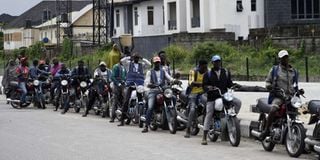Nigeria records 21.8 million jobless people after Covid-19 effects

In this file photo taken on September 4, 2019, regular motorcycle taxis, locally known as an okada, queue for passengers in Lagos, Nigeria. The National Bureau of Statistics (NBS) put the figure of unemployed Nigerians at 21,764,617 as at the end of June.
What you need to know:
- The National Bureau of Statistics (NBS) put the figure of unemployed Nigerians at 21,764,617 as at the end of June as the country’s covid-19 cases almost hit 50,000.
- The unemployment rate during the period in reference represented a 27.1 per cent rise from the 23.1 per cent recorded in the third quarter of 2018.
- According to the report, the total number of people in employment during the reference period was 58,527,276.
- The statistic of those employed showed a 15.8 per cent reduction in employment in the third quarter of 2020.
Abuja,
The number of unemployed people in Nigeria has spiked to 21.8 million following the negative impact of the Covid-19 pandemic on the private sector.
The National Bureau of Statistics (NBS) put the figure of unemployed Nigerians at 21,764,617 as at the end of June as the country’s covid-19 cases almost hit 50,000.
Many private firms have rationalised their workforce and service industries have given up their sprawling office spaces and directed staff to work from home.
The statistics on the employment situation are contained in NBS’ Labour Force Statistics website, entitled “Unemployment and Underemployment Report (Q2 2020)’’ released in Abuja on August 15.
It referred to the report as an Abridged Labour Force Survey under Covid-19 for August 2020.
The unemployment rate during the period in reference represented a 27.1 per cent rise from the 23.1 per cent recorded in the third quarter of 2018.
“A rise in unemployment generally means the number of people searching for jobs has increased, which can occur because people previously outside the labour force have decided to join the labour force and are now in search of jobs,” the NBS said.
“Or people previously working have lost their jobs and are now in search of jobs. Often, it is a combination of these two.”
Employment figures
According to the report, the total number of people in employment during the reference period was 58,527,276.
The statistic of those employed showed a 15.8 per cent reduction in employment in the third quarter of 2020.
Of this number, 35,585,274 were full-time employed, who worked for 40 hours or more per week, while 22,942,003 were under-employed and worked between 20 to 29 hours per week.
The number of persons in the labour force, people within ages 15 and 64 and able and willing to work, was estimated to be 80,291,894.
The figure represented an 11.3 per cent decrease in the number of persons recorded in the third quarter of 2018.
Of this number, those within the age bracket of 25 to 34 were the most at 23,328,460, representing 29.1 per cent of the labour force.
Rural dwellers
The NBS noted that the unemployment rate among rural dwellers in the period under review increased to 28 per cent from 23.9 per cent in the third quarter of 2018.
Urban dwellers also reported a rate of 25.4 per cent up from 21.2 per cent.
In the case of underemployment among rural dwellers, the rate rose to 31.5 per cent in the period under review from 22.8 per cent in the third quarter of 2018.
The rate among urban dwellers also rose to 23.2 per cent from 13.7 per cent in the third quarter of 2018.
The unemployment rate among young people, ages 15 to 34, in the second quarter of 2020 was 34.9 per cent up from 29.7 per cent in the third quarter of 2018.
Also, the rate of underemployment for the same age group rose to 28.2 per cent from 25.7 per cent.
These rates were the highest when compared to other age groupings.
State statistics
For state statistics under the second quarter of 2020, Imo State reported the highest rate of unemployment with 48.7 per cent, followed by Akwa-Ibom and Rivers with 45.2 per cent and 43.7 per cent respectively.
The state with the lowest rate was Anambra in the South-East with 13.1 per cent.
For underemployment, the state which recorded the highest rate was Zamfara with 43.7 per cent, while Anambra recorded the lowest underemployment rate of 17 per cent.
A total of 2,736,076 people did not do any work in the seven days preceding the survey due to the lockdown but had secure jobs to return to.
The NBS said the unemployment and underemployment rates varied across states according to the nature of economic activities predominant in each one.
“Favourable conditions in one state may lead to an influx of jobseekers in that state and in the process increase unemployment in the performing state, while reducing the unemployment rate in the originating state,” it explained.
“This may give a false impression that the state with the lower unemployment rate is performing better.”





